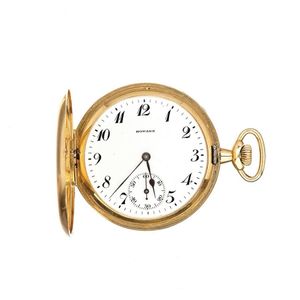Gold James Poole Chronometer Pocket Watch with Fob Chain
You must be a subscriber, and be logged in to view price and dealer details.
Subscribe Now to view actual auction price for this item
When you subscribe, you have the option of setting the currency in which to display prices to $Au, $US, $NZ or Stg.
- Movement - The technical name for the workings of a clock or watch, and does not include the dial or case.
- Detente Escapement - A detente escapement is a type of mechanism used in mechanical watches and clocks. It is a variation of the lever escapement, and is known for its high precision and accuracy. The detente escapement is composed of two main parts: the escape wheel, which is driven by the watch or clock's mainspring, and the lever, which is responsible for locking and unlocking the escape wheel.
The lever has two pallets, one for locking and one for unlocking the escape wheel. The locking pallet stops the wheel from rotating while the unlocking pallet allows the wheel to rotate. As the wheel rotates, it pushes the lever, causing the pallets to alternately lock and unlock the wheel in a precise manner. This action allows the wheel to release energy in small, precise increments, which drives the clock or watch's hands. The detente escapement is considered to be one of the most accurate escapements available, and is often used in high-end timepieces. - Fusee - The fusee movement was used in clocks and pocket watches from the mid 17th century. The fusee is a cone shaped drum within the works that is linked to the barrel of the spring, usually by a length of chain.
As the mainspring loses its tension over time, the cone shaped barrel compensates for this by increasing the tension, by pulling the mainspring tighter, thus ensuring the time remains constant.
Use of the fusee in clocks was superseded by the "going barrel" in the mid 19th century and for pocket watches at the beginning of the 19th century.
The fusee continued to be used in marine chronometers until the 1970s.
This item has been included into following indexes:
Visually similar items

A gentleman's gold openface pocket watch, James Shead, Oxford. 45 mm. Key wind. Movement number 8959. Movement signed. White enamel dial, black Roman numerals, subsidiary seconds and up-and-down indicator.18ct yellow gold. Total weight 83.00 grams. Hallmar

A gentleman's gold openface pocket stopwatch, Longines. 52 mm. Crown wind. Case, dial and movement signed. White enamel dial, black Roman numerals, subsidiary seconds and 30 minutes recorder. Plain polished case. 14ct yellow gold. Total weight 110.85 grams

A good gold Howard watch Co. Hunter pocket watch, c.1910, stamped 18ct gold keystone case, N.176915. The lever movement N.1267130 with bimetallic balance and micrometer adjustment, 17 jewels. Good enamel dial with one small faint hairline, with case and pa

Waltham Watch Co. An 18ct gold hunting cased watch no 6983846 retailed by Schierwater & Lloyd Liverpool American circa 1900, manual winding lever movement, fully jewelled, white enamel dial, black painted Roman numerals, gilt hands, subsidiary seconds, out
